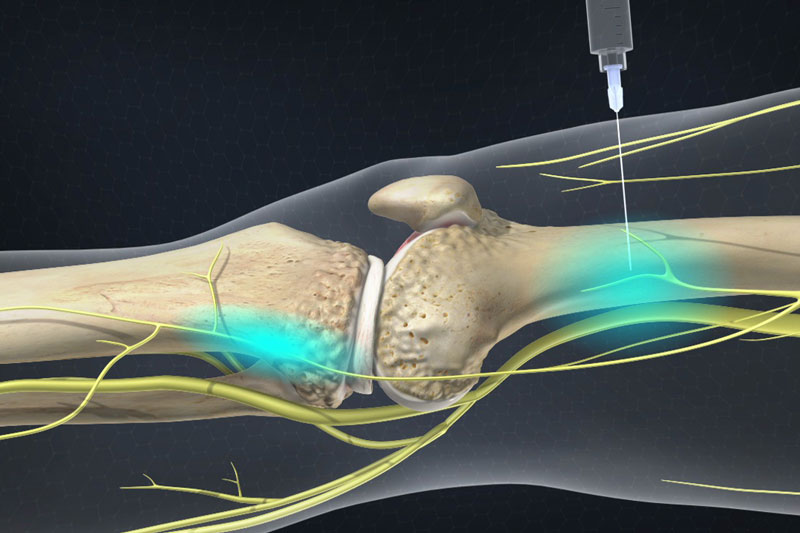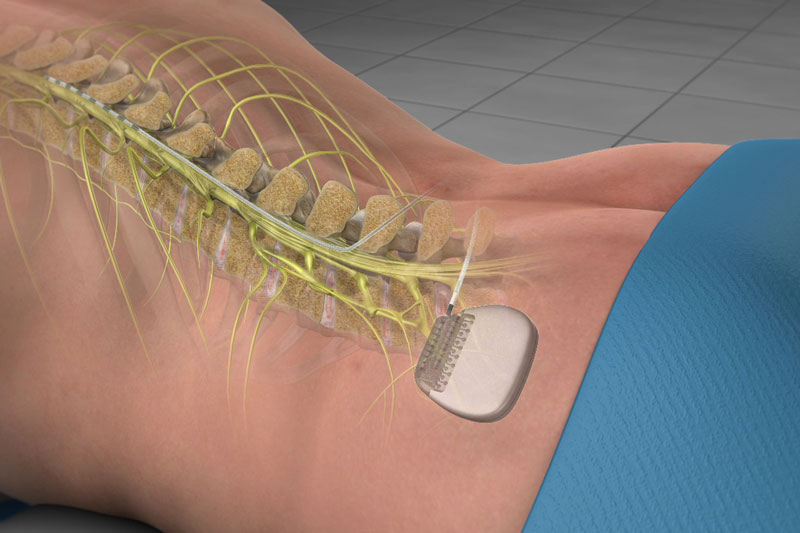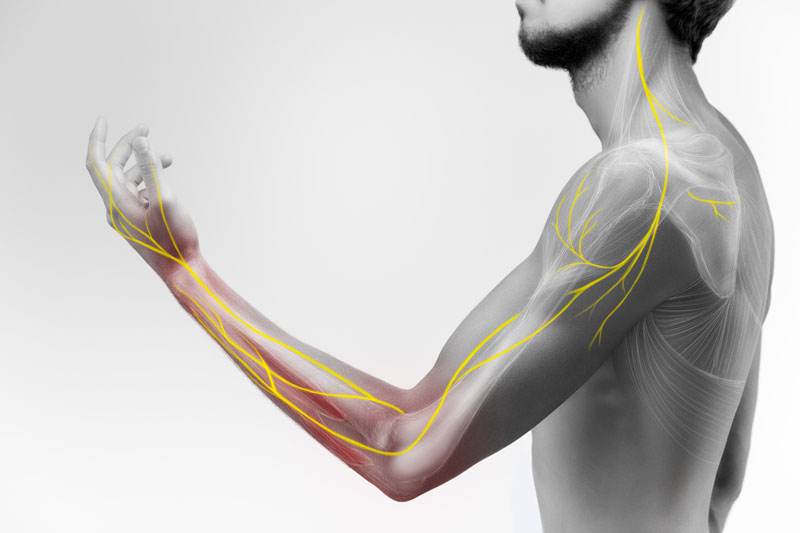Nerve stimulation, in the context of medical treatment, refers to a therapeutic approach that involves the use of electrical impulses to influence or modulate the activity of nerves in the body. This technique is employed to manage various painful conditions and can have diverse applications.
Nerve stimulation capitalizes on the body’s intricate nervous system, which plays a crucial role in transmitting messages between the brain and various parts of the body. By delivering controlled electrical impulses to specific nerves or nerve pathways, healthcare providers can either inhibit or enhance nerve activity to achieve therapeutic effects. Several types of nerve stimulation include:
- Transcutaneous Electrical Nerve Stimulation (TENS)
- Spinal Cord Stimulation (SCS)
- Peripheral Nerve Stimulation (PNS).
Radiofrequency ablation (RFA) is a minimally invasive medical procedure used to treat various conditions that cause chronic pain, particularly pain originating from the joints, nerves, or soft tissues. It is a well-established technique that offers targeted pain relief by using heat generated by radiofrequency energy to disrupt or reduce the transmission of pain signals from affected nerves or tissues.
RFA operates on the principle that heat can interrupt the functioning of specific nerve fibers responsible for transmitting pain signals to the brain. By selectively applying heat to these nerves or tissues, RFA can provide relief from chronic pain conditions such as:
- Facet joint pain (in the spine)
- Sacroiliac joint pain
- Nerve pain (neuropathic pain)
- Arthritis of the knee
- Arthritis of hip
- Arthritis of the shoulder
It is often considered when conservative treatments, such as physical therapy or other injections have not provided sufficient relief. RFA offers several advantages, including minimal risk of infection, a short recovery period, and the potential for improved mobility and quality of life for individuals suffering from chronic pain.
At Ponte Vedra Spine and Pain, our mission is to provide compassionate, patient-centered care to residents in Ponte Vedra and the surrounding areas. We are committed to helping you find treatment options such as spinal cord stimulation, peripheral nerve stimulation, and radiofrequency ablations. Our experienced team utilizes the latest techniques and technologies to ensure you receive the most effective and minimally invasive treatments available. Contact us today to schedule a consultation and take the first step towards a pain-free future.
What is Spinal Cord Stimulation and Radiofrequency ablation?
Nerve Stimulation and Radiofrequency Ablation (RFA) are two distinct medical procedures used to manage chronic pain and certain neurological conditions by targeting nerves or neural pathways. Here’s a brief explanation of each:
Nerve Stimulation:
Basic Principle: Nerve stimulation, also known as neuromodulation, involves using electrical impulses to influence nerve activity. It aims to disrupt or modulate pain signals, providing relief for individuals with chronic pain or neurological conditions.
Types: There are various types of nerve stimulation techniques, including:
- Transcutaneous Electrical Nerve Stimulation (TENS): Involves placing electrodes on the skin to deliver low-level electrical currents, which can help manage pain by altering pain signal perception.
- Spinal Cord Stimulation (SCS): Involves implanting a device under the skin that delivers electrical impulses directly to the spinal cord to reduce pain signals, often used for chronic back or leg pain.
- Peripheral Nerve Stimulation (DBS): Similar to SCS, peripheral nerve stimulation uses electrical impulses applied directly to a peripheral nerve to reduce or block pain signals.
Applications: Nerve stimulation can be used to treat various conditions, including chronic pain of the joints, nerves, and spine.
Radiofrequency Ablation (RFA):
Basic Principle: Radiofrequency ablation is a minimally invasive procedure that uses heat generated by radiofrequency energy to disrupt or reduce the transmission of pain signals from specific nerves or tissues. It provides targeted pain relief by creating a lesion or ablation zone.
Types: There are several types of ablation procedures including:
- Radiofrequency: Ablation using heat
- Cryoablation: Ablation using cold instead of heat
- Chemical: Ablation using a caustic substance such as phenol
Applications: RFA is commonly used to manage chronic pain conditions such as facet joint pain, sacroiliac joint pain, and neuropathic pain. It is often considered when conservative treatments have not provided sufficient relief.
In summary, nerve stimulation and radiofrequency ablation are both medical interventions used to manage chronic pain and neurological conditions. Nerve stimulation involves the use of electrical impulses to modulate nerve activity, while RFA uses heat to disrupt pain signal transmission from specific nerves or tissues. The choice between these procedures depends on the patient’s condition, the location of the pain, and the expected duration of relief.

Why are Nerve Stimulation or Radiofrequency Ablations Performed?
Nerve stimulation and radiofrequency ablation (RFA) are performed to manage and alleviate chronic pain and certain neurological conditions that can significantly impact a person’s quality of life. Here’s why these procedures are performed:
Nerve Stimulation:
- Chronic Pain Management: Nerve stimulation techniques, such as spinal cord stimulation (SCS) and transcutaneous electrical nerve stimulation (TENS), and Peripheral Nerve Stimulation (PNS) are employed to manage chronic pain conditions that have not responded well to other treatments. These may include chronic back pain, chronic neck pain, leg pain, arm pain, neuropathic pain (nerve pain), and complex regional pain syndrome (CRPS).
- Neuropathic Pain Relief: Neuropathic pain often results from abnormal nerve activity and can be challenging to treat with traditional treatments. Nerve stimulation can disrupt or modulate the pain signals being sent to the brain, providing relief for individuals with conditions like diabetic neuropathy, post-herpetic neuralgia (shingles pain), or damaged nerves after surgery.
- Minimally Invasive Option: Nerve stimulation procedures are minimally invasive and can offer an alternative to more invasive surgical interventions. They often have shorter recovery times and fewer risks compared to open surgeries.
Radiofrequency Ablation (RFA):
- Chronic Pain Treatment: RFA is primarily used to manage chronic pain conditions that arise from specific nerves or tissues. It is considered when other conservative treatments like medications, physical therapy, or injections have not provided adequate relief.
- Targeted Pain Relief: RFA provides targeted pain relief by creating lesions or ablation zones that interrupt the transmission of pain signals along specific nerve pathways. It is commonly used for conditions like spine pain, back pain, neck pain, knee pain, shoulder pain, sacroiliac joint pain, and certain neuropathic pain syndromes.
- Improved Functionality: By reducing or eliminating pain, RFA can improve a patient’s functionality, mobility, and overall quality of life. It allows individuals to engage in activities they might have had to avoid due to chronic pain.
- Minimally Invasive Nature: RFA is a minimally invasive procedure that requires only the use of needles which means less pain and shorter recovery times compared to open surgeries.
Both nerve stimulation and RFA procedures aim to enhance a patient’s well-being by managing chronic pain and neurological conditions that can be otherwise challenging to treat effectively. The choice of procedure depends on the specific condition, the location of the pain, the patient’s overall health, and the expected duration of pain relief. These treatments are typically considered when more conservative approaches have not provided satisfactory results.
How are Nerve Stimulation or Radiofrequency Ablations Performed?
Here’s an overview of how each of these procedures is typically performed:
Nerve Stimulation: Nerve stimulation procedures, such as spinal cord stimulation (SCS) involve the use of electrical impulses to decrease painful nerve impulses.
- Preparation: The patient is typically prepared by receiving local anesthesia to numb the area where the procedure will take place. In some cases, mild sedation or anesthesia may be used to ensure comfort during the procedure.
- Electrode Placement: A physician will carefully insert thin wires (leads) with electrode tips through a needle near the spinal cord. The placement is guided by imaging techniques such as fluoroscopy (real-time X-ray) to ensure accuracy.
- Testing and Adjustment: The system is tested to ensure it provides the desired pain relief. The patient can provide feedback during this process to help adjust the settings for optimal pain management.
- Activation: Once the system is adjusted and provides effective pain relief, it is activated and programmed. The patient can typically control the device settings using a handheld programmer.
Radiofrequency Ablation (RFA): RFA is a minimally invasive procedure that uses heat generated by radiofrequency energy to disrupt pain signals from specific nerves or tissues.
- Preparation: Local anesthesia is administered to numb the treatment area. Sometimes, sedation or mild anesthesia is provided to keep the patient comfortable.
- Image Guidance: Imaging techniques like fluoroscopy (X-ray) or ultrasound are used to guide the healthcare provider in accurately placing a needle or electrode near the targeted nerves or tissues.
- Heat Application: Radiofrequency energy is applied through the needle or electrode to generate heat, creating a lesion or ablation zone. This disrupts or reduces the transmission of pain signals.
- Confirmation: The provider may conduct tests to confirm that the ablation has been successful in reducing pain signals.
Both nerve stimulation and RFA are generally well-tolerated and can provide effective pain relief. The choice of procedure depends on the specific condition and patient needs.
What To Expect After Nerve Stimulation or Radiofrequency Ablations
After undergoing nerve stimulation or a radiofrequency ablation (RFA) procedure, there are specific expectations and considerations for post-procedure care and recovery. Here’s what you can generally expect:
Nerve Stimulation (e.g., Spinal Cord Stimulation):
1. Immediate Post-Procedure Period:
- You may experience some discomfort or soreness at the incision or electrode insertion sites.
- There might be temporary swelling or bruising at the procedure site.
- The pulse generator (battery) is typically programmed and activated during the procedure.
2. Recovery and Adjustments:
- In the days and weeks following the procedure, you will likely have follow-up appointments with your healthcare provider.
- During these appointments, the settings of the stimulation device will be adjusted as needed to optimize pain relief.
- You will learn how to use a handheld programmer to control the device settings.
- It may take some time to find the ideal settings that provide the best pain relief.
3. Activity and Lifestyle:
- You can usually resume most daily activities, including light exercise, after the initial recovery period.
- It’s essential to follow your physician’s recommendations regarding physical activity restrictions and limitations.
- Inform your healthcare provider if you notice any unusual changes in your condition or if the device is not providing the expected pain relief.
4. Medications:
- Depending on your condition and individual response to nerve stimulation, you may need to adjust or reduce pain medications as pain relief improves.
Radiofrequency Ablation (RFA):
1. Immediate Post-Procedure Period:
- You may experience some discomfort or pain at the treatment site immediately after the procedure. This is usually manageable with over-the-counter pain relievers or prescription medications prescribed by your physician.
2. Activity and Recovery:
- Recovery time after RFA is relatively short, and you can typically resume light activities the same day or next day.
- It’s advisable to avoid strenuous activities for a brief period to allow the treated area to heal.
3. Pain Relief:
- You may not experience immediate pain relief after RFA. It often takes a few days to weeks for the full benefits to become apparent as the nerves or tissues respond to the ablation.
4. Follow-up Appointments:
- You will likely have a follow-up appointment with your healthcare provider to assess the effectiveness of the procedure.
- Depending on your response to RFA, you may require repeat procedures if the pain returns over time.
5. Monitoring and Communication:
- Pay attention to how your pain changes following the procedure and communicate any improvements or concerns with your physician.
- If you experience any unusual symptoms, such as signs of infection or worsening pain, contact your healthcare provider promptly.
It’s essential to follow your physician’s post-procedure instructions carefully, including any prescribed medications, activity restrictions, and recommended follow-up appointments. Your physician will work with you to optimize the effectiveness of the treatment and ensure your comfort and well-being during the recovery process.
Frequently Asked Questions About Nerve Stimulation and Radiofrequency Ablation
Here’s a list of frequently asked questions (FAQs) about nerve stimulation and radiofrequency ablation (RFA), along with brief answers:
Nerve Stimulation FAQs:
1. What is nerve stimulation, and how does it work?
- Nerve stimulation involves using electrical impulses to modulate nerve activity. It can disrupt or modulate pain signals, providing relief for chronic pain conditions.
2. What are the different types of nerve stimulation procedures?
- Common types include spinal cord stimulation (SCS), transcutaneous electrical nerve stimulation (TENS), and peripheral nerve stimulation (PNS).
3. Who is a candidate for nerve stimulation?
- Candidates often have chronic pain conditions that have not responded well to other treatments, and they are assessed by healthcare providers to determine suitability.
4. Is nerve stimulation painful?
- During the procedure, local anesthesia is used to minimize discomfort. The electrical impulses may cause tingling or mild sensations but are not typically painful. Often times, the patient will feel nothing but reduced pain.
5. How long does pain relief from nerve stimulation last?
- Pain relief duration varies by individual and condition. Some experience temporary relief, while others have longer-lasting benefits. The treatment can be adjusted as needed.
Radiofrequency Ablation (RFA) FAQs:
1. What is RFA, and how does it work?
- RFA is a minimally invasive procedure that uses heat generated by radiofrequency energy to disrupt or reduce pain signals from specific nerves or tissues.
2. What conditions can RFA treat?
- RFA is commonly used to manage chronic pain conditions such as facet joint pain, sacroiliac joint pain, and certain neuropathic pain syndromes.
3. Is RFA a permanent solution for pain?
- RFA can provide long-lasting relief for some individuals, but the duration of pain relief can vary. Repeat procedures may be necessary if the pain returns over time.
4. Is RFA painful during or after the procedure?
- Local anesthesia is used to minimize discomfort during the procedure. Afterward, patients may experience temporary discomfort or soreness at the treatment site.
5. How quickly can I resume normal activities after RFA?
- Recovery time is relatively short, and most patients can resume light activities within a day. Strenuous activities may be limited for a short period.
These FAQs provide a general understanding of nerve stimulation and RFA procedures. However, specific details may vary based on the patient’s condition and the recommendations of their physician.













